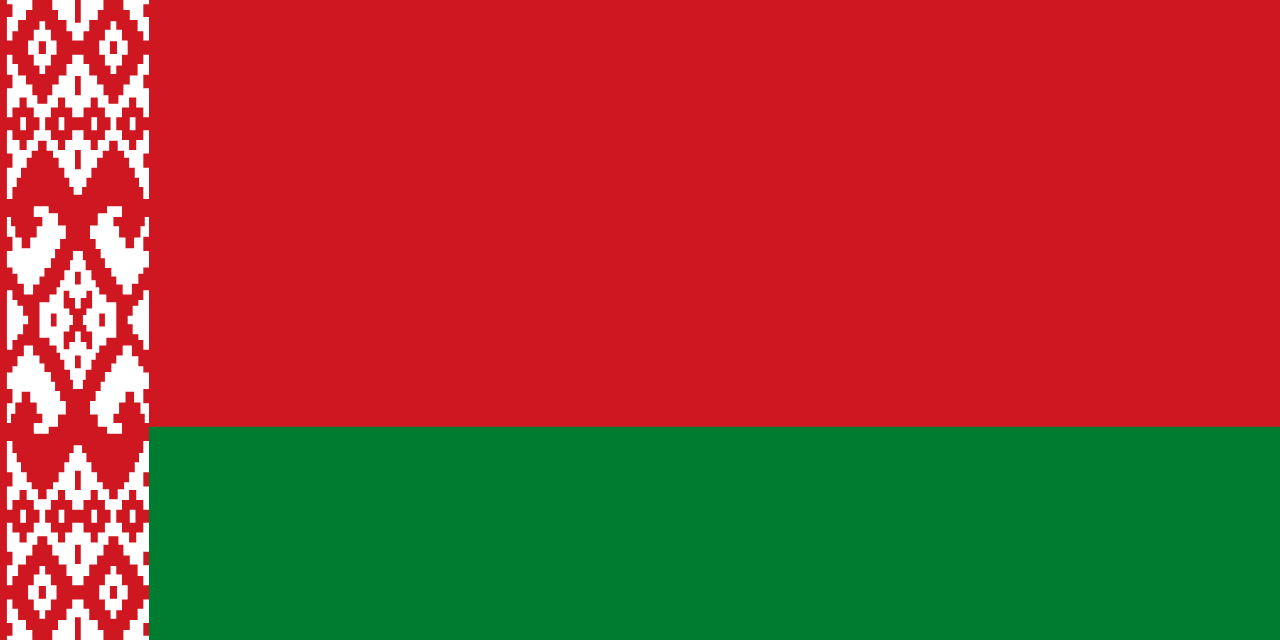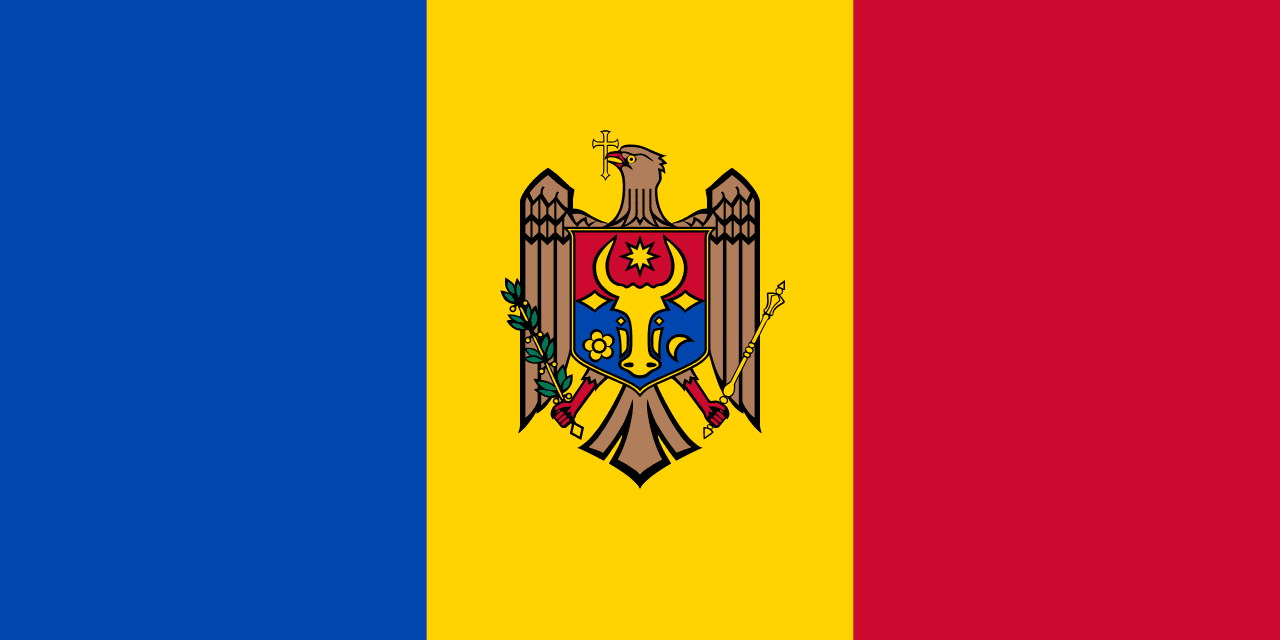Belarus Flag Meaning
A red horizontal stripe over a green stripe with a traditional red and white ornamental pattern on the hoist side, representing the historical heritage of Belarus, its forests and agriculture, and the decorative folk art traditions that define Belarusian cultural identity.
- Continent
- Europe
- Adopted
- 1995
- Ratio
- 1:2
- Colors
- red, green, white
- Designer
- Unknown

Symbolism
Red Stripe: Represents the glorious past of Belarus and the courage of the Belarusian army, symbolizing the blood shed by Belarusians throughout history in defense of their homeland and the revolutionary spirit of the people.
Green Stripe: Represents the forests that cover much of Belarus and the agricultural wealth of the nation, symbolizing hope for the future, the connection to nature, and the fertile lands that sustain the population.
Ornamental Pattern: Features traditional Belarusian folk embroidery designs that have been passed down through generations, representing the rich cultural heritage, artistic traditions, and the continuity of Belarusian identity through centuries of foreign rule.
White in Pattern: Represents the spiritual purity of the Belarusian people and their peaceful nature, symbolizing the quest for harmony and the desire for good relations with neighboring peoples.
History
- 6th-9th Century: Slavic tribes settled in the region between the Dnieper and Western Dvina rivers, establishing early principalities that would later become part of the medieval Belarusian identity.
- 14th-16th Century: The Grand Duchy of Lithuania, largely populated by Belarusians and using Old Belarusian as its official language, became one of the largest European states, stretching from the Baltic to the Black Sea.
- 1569-1795: The Polish-Lithuanian Commonwealth brought Polish cultural influence and Catholicism, while many Belarusian nobles adopted Polish customs, creating lasting religious and cultural divisions.
- 1795-1917: Russian partition brought intensive Russification policies, with Russian language replacing Belarusian in administration and education, and Orthodox Christianity being promoted over Catholicism.
- 1918-1922: Brief independence as the Belarusian People's Republic ended with Soviet incorporation, though the Bolsheviks initially promoted Belarusian language and culture through korenization policies.
- 1922-1991: Soviet rule brought industrialization and urbanization but also severe repression, including Stalin's purges that devastated Belarusian intellectual and cultural leadership in the 1930s.
- 1941-1944: Nazi occupation resulted in the Holocaust that killed most of Belarus's Jewish population and partisan warfare that devastated the country, with about 25% of the population dying during the war.
- 1986: The Chernobyl nuclear disaster contaminated about 20% of Belarusian territory, causing long-term health and environmental problems that continue to affect the country today.
- August 25, 1991: Belarus declared independence from the Soviet Union during the collapse of communism, initially adopting a white-red-white flag that became a symbol of democratic opposition.
- July 10, 1994: Alexander Lukashenko was elected president in the first and last free presidential election, beginning what would become Europe's longest-serving dictatorship.
- May 14, 1995: The current flag was adopted following a controversial referendum that also strengthened presidential powers and made Russian an official language alongside Belarusian.
- 2020: Massive protests following disputed presidential elections challenged Lukashenko's rule, with hundreds of thousands demanding democracy and the opposition adopting the white-red-white flag as their symbol.
- 2021-Present: Violent crackdown on protests led to mass arrests and emigration of opposition leaders, while increased dependence on Russia has raised questions about Belarusian sovereignty and independence.
Trivia
- Belarus is often called 'Europe's last dictatorship' due to Alexander Lukashenko's authoritarian rule since 1994, longer than any other European leader in modern times.
- The flag represents a country where the 2020 democratic protests adopted the historic white-red-white flag as a symbol of resistance against the current government.
- Belarus was the most affected country by the 1986 Chernobyl nuclear disaster, with about 20% of its territory contaminated and ongoing health consequences for the population.
- The country is known as the 'lungs of Europe' due to its vast forests, which cover about 40% of the territory and include the primeval Białowieża Forest shared with Poland.
- Traditional Belarusian cuisine features hearty dishes like draniki (potato pancakes), machanka (pork stew), and kalduny (dumplings), reflecting the agricultural heritage.
- The flag flies over a country where the Belarusian language, while official, is spoken by only about 20% of the population, with Russian being dominant in daily life.
- Belarus has one of the world's highest literacy rates and strong educational traditions, inherited from the Soviet emphasis on universal education and technical training.
- The country is landlocked and strategically located between Russia and the European Union, making it a crucial transit route for energy and trade between East and West.
- Minsk, the capital, was almost completely destroyed during World War II but was rebuilt in the Stalinist architectural style, creating a uniquely preserved Soviet-era cityscape.
- Belarus is known for producing world-class athletes, particularly in ice hockey, biathlon, and gymnastics, with many competing internationally despite political restrictions.
- The flag represents a country with significant industrial heritage, including heavy machinery, chemicals, and textiles, though much of the economy remains state-controlled.
- Traditional folk arts including weaving, embroidery, and woodcarving remain important cultural expressions, with the flag's ornamental pattern celebrating these traditions.
- Belarus has close economic and political ties with Russia through the Union State agreement, leading to questions about sovereignty and independence.
- The country has strict media controls and internet restrictions, with independent journalism and civil society organizations facing severe pressure and persecution.
- Despite political repression, Belarus maintains a rich cultural heritage including literature, music, and theater, with many artists and intellectuals now living in exile.
Related Countries

Lithuania
Europe
Three horizontal stripes of yellow, green, and red representing the golden wheat fields, green forests, and blood shed for independence of this Baltic nation that led the peaceful dissolution of the Soviet Union.

Latvia
Europe
Three horizontal stripes with dark red (maroon) stripes on top and bottom and a narrow white stripe in the center, representing one of the world's oldest flag designs dating back to medieval times and Latvia's struggle for independence.

Estonia
Europe
Three horizontal stripes of blue, black, and white representing the sky and sea, the soil and past struggles, and the snow and bright future of this Baltic nation known for its digital innovation and preserved medieval heritage.

Poland
Europe
A simple bicolor of white over red, reflecting Poland’s heraldry and national identity. The design is among the simplest yet most recognizable European flags.

Ukraine
Europe
Two horizontal bands of blue over yellow, representing the blue sky over golden wheat fields that symbolize Ukraine as the 'breadbasket of Europe,' with colors that have represented Ukrainian identity for centuries and were officially adopted after independence from the Soviet Union.

Moldova
Europe
Three vertical stripes of blue, yellow, and red with the national coat of arms centered on the yellow stripe, representing Moldova's emergence from Soviet rule and its historical connections to Romanian heritage and European identity.